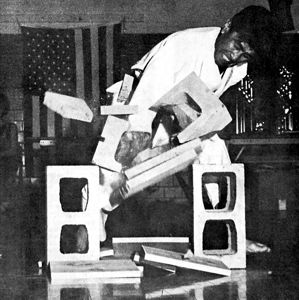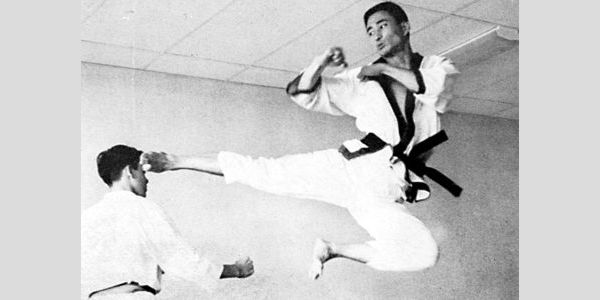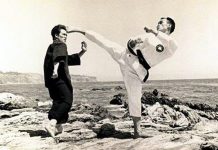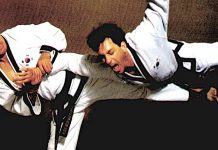From 1970 to date, Tae Kwon Do experienced its most explosive growth in the Western world. It became arguably the most popular martial art practiced in the U.S. and an Olympic demonstration sport. Here’s how it happened.
The Second Generation
It’s been estimated that just over 25 Korean TKD masters had settled in the United States by the mid 1960s. By the late 1960s, a span of only four or five years, that number increased to over 800. Reputedly, more than 1,200 Korean TKD instructors had emigrated to the United States by the early 1970s.
At the same time, Americans trained in TKD were evolving from the traditional art to an Americanized form of martial art. By 1970, in fact, Americans had produced a new generation of their own black belts who had not trained at all under Korean teachers. Meanwhile the surging popularity of the martial arts in the U.S. had resulted in a surprising growth in the number of “open” karate tournaments, and the new wave of martial arts magazines gave instant recognition to those competitors skilled enough to be successful. Many of these new media heroes had a TKD background.
That’s not all. Much of the development of modern sport karate in the West can be traced to the efforts of TKD stylists during the 1970s. In 1972, Mike Anderson, a Blackbelt of TKD pioneer Allen Steen‘s, launched Professional Karate magazine, the first publication devoted exclusively to the sport. The next year, he promoted the Top Ten Nationals in St. Louis, at which “semi contact” karate was created. This came about when Anderson made mandatory the use of the new foam rubber sparring gear created by Jhoon Rhee. The innovation revolutionized sport karate by permitting moderate contact without fear of injury.
In September 1974, Anderson produced the first world scale full contact championships in Los Angeles. Two of the four world kickboxing champions crowned there had TKD roots, Washington, D.C.’s Jeff Smith, a light heavyweight and student of Jhoon Rhee‘s, and Mexico City’s Isaias Duenas, a lightweight and protege of TKD pioneer David Moon. (The other two original world champions were middleweight Bill Wallace, undisputedly the sport’s finest kicker, and heavyweight legend Joe Lewis.)
Split in the Homeland
But while this “Americanization” of TKD was going on most Korean instructors were trying to maintain control of what was supposed to be, after all, a Korean art. This was complicated by political upheavals occurring back in Korea.
General Choi Hong Hi, founder of the International Taekwon do Federation (ITF), left Korea some say he fled for political reasons for Canada in 1972. The following year the rival World Taekwon do Federation (WTF) was formed as the new Korean authorized international controlling body for the art and budding sport. This dichotomy forced Korean instructors to around the world to take sides with one faction or the other.
To further distance themselves from Gen. Choi and his approach to TKD, the WTF created a new set of training patterns, the Palgwes, to which all members were to adhere. Many of the Korean American instructors at the time were reluctant to change their forms, however, and some adamantly refused.
Amateur Tae Kwon Do Competition
For years TKD instructors had dreamed of seeing their sport in the Olympic games, alongside judo. But the general public and the Olympic administrative hierarchy, saw it as just another form of karate, and karate was considered to factionalized to have any real hopes of Olympic participation.
But a giant step was made in 1972 when the AAU (Amateur Athletic Union) in the U.S. recognized TKD as a sport separate from karate. One of the principal movers and shakers who brought this about was Ken Min, the TKD coach at the University of California at Berkeley. “When I first came to this country in 1962,” says Min, “I learned that in order to be recognized by the United States sports world you had to be recognized by the AAU.”
Being an instructor of yudo (Korean judo) and TKD, Min felt, as did many of his countrymen, that TKD was distinct from karate and should not be classified with the Japanese art and sport. “Even though they are neighbors,” Min explains, “I argued that they should be separated and not be put into the same sports format. At that time I saw a great difference between the two.”

Min’s arguments paid off and the AAU voted in TKD as an official sport in November 1973. In 1974 the first National AAU Tae Kwon Do Invitational Championships was held at Berkeley.
In 1979 the International Olympic Committee (IOC) approved TKD as a sport worthy of Olympic recognition. This meant that the sport would now be “eligible” for selection into the games. According to Min, the IOC requested that the AAU TKD organization not use the AAU name; hence, the United States Taekwon do Union (USTU) was formed, and remains today the only official American organization recognized by the WTF in Korea and responsible for organizing the national competitions for Olympic TKD hopefuls.
(Editor’s Note: Since this article was written in 1992, Taekwondo was voted in as a permanent Olympic sport in the year 2000. There has been controversy, however, over whether or not to drop it in future years. Only time will tell.)
Other TKD Organizations Emerge
The 1970s also marked the formation of several other TKD organizations founded by both Koreans and Americans. Most of them are small to moderate sized groups and to mention some without others would be inappropriate here. The United States Taekwon do Federation (USTF), spawned in 1974 in Chicago, is notable, however, because it is the American branch of Gen. Choi’s ITF.
And, in part one of this article we mentioned the American Taekwon do Association (ATA), which was formed in 1969 and is today one of the largest martial arts organizations in this country, if not the world. It grew slowly at first, but because of the charismatic leadership of Master Haeng Ung Lee, the business savvy of cofounder Richard Reed, and the ATA’s independent nature it developed a huge following.
Richard Reed of San Francisco is the American who originally brought Lee to the United States and who has been instrumental in building the ATA into its present status. “Democracy doesn’t work in a situation like this,” Reed maintains. “If you give everybody an equal vote they are just not all qualified to make judgements.”
The ATA is governed by a strict set of rules. They are militaristic in nature and are usually inflexible. Reed says that the ATA decided early on not to let their students and members attend open tournaments. “In the 1970s the magazines were making heroes out of guys with no technique, but front kick, punch,” he claims. “Sure, we discouraged students from going to open tournaments, because they were not conducted in a manner conducive to proper martial arts.”
So in the seventies the ATA created its own system and circuit of closed, members only tournaments where control, variety of technique and sportsmanship were emphasized over winning. Open competitors claimed that the level of competition was decidedly lower than that found on the American karate tournament circuit.
“That was a valid point at one time,” Reed admits, but today we have enough people that we are bound to have some real talent.” Indeed, the ATA’s national championships have been known to draw over 2,500 competitors.
TKD in the Eighties
Because of the diverse nature of TKD in America it is difficult to accurately reflect the more recent history of this art and sport. There are, in effect, several distinct groups: 1) American run schools, usually independent or belonging to an association of their own creation and often referring to their style as “karate”; 2) Korean run schools, usually members chiefly of the WTF or, secondarily, the ITF; 3) independent Koreans who have started their own organizations; 4) Americans who have decided to remain with or join the WTF.
Texan Roy Kurban is one such American who, after coming up the ranks in an independent school and being ranked in the national top 10 among open tournament fighters, decided to affiliate with the WTF. Says Kurban, “They are the official Korean Tae Kwon Do governing body, no matter what anybody else says. I looked at all the different groups, and while I don’t agree with everything the WTF does, this organization has many more good points than bad.
Kurban admits that he had become disgusted with the atmosphere at open tournaments and has been impressed with the manner in which the USTF’s (the VVTF’s American branch) competitions are organized and conducted. “It’s amazing to me to see how they (the Koreans) have really j ust come to this country, some of them still having trouble with the language, and have organized this well,” he says. “After twenty five years the Americans and their tournaments are still in a total state of disarray.”
Kurban says that he has been fortunate to have trained with some true Korean masters, citing Park Won Chik in particular, and claims that his WTF affiliations have helped him gain students and have made him a better instructor.
Los Angeles’ Hee 11 Cho is an eminent master of TKD who is regarded as one of the world’s greatest kicking technicians. He trained with Gen Choi of the ITF, was a member of the ATA at one time, and who has a rank certificate from the WTF. “I don’t presently belong to any [of these] associations, but that doesn’t mean I don’t cooperate with them,” he says. “But this way I don’t have to be involved in their fight because I am independent.”
Cho still practices the first TKD forms (the Chunji hyungs [patterns] designed by Gen. Choi) and feels that requiring schools to change to a new set of forms only dilutes the unity of TKD. “Maybe it is part political, maybe they think it is more efficient,” says Cho of the creation of new patterns. My goal is not to control the art and say you have to change this or that. We are openminded and accept anybody,” he says of his own organization.
Although Master Cho has been involved in promoting tournaments and even full contact bouts both in this country and abroad over the years, he still feels that TKD should be a martial art first and a sport second. “How many people want to be involved in the WTF style of fighting,” he asks. “I don’t think even two percent of people have that goal. They are more interested in self defense, physical fitness, and so on.”
Cho believes schools that teach the Olympic style of TKD are “not offering anything to the average person, but are only collecting money. Let them call it “Tae Kwon Sport,’ and let those of us who emphasize a total spiritual approach call it `Tae Kwon Do,”‘ he says.
Grandmaster Jhoon Rhee, the father of TKD in America, is another independent Korean who laments the direction the WTF is taking his beloved art. He voices Hee Il Cho’s words almost exactly when he says, “They are taking the `Do’ out of Tae Kwon Do.”
Henry Cho of New York City and Oklahoma City’s Jack Hwang, two early TKD pioneers, are both affiliates of the WTF. Nevertheless, they, too, lament the emphasis on competition that has characterized the WTF in recent years.
Hwang believes that TKD in the eighties and nineties seems much too preoccupied with the sport aspects. He says sparring is but a very small part of his teaching regimen. “Ninety percent has to be art before sport;” he says. “If we can keep it that way then maybe this art can go another hundred years.”
Henry Cho agrees, adding that he still teaches the way he did when he came to America in 1958. He wouldn’t even change to the new set of forms when they were introduced. “I did not understand the reason for changing and so I do what I already know,” he explains.
“I came to study and live here,” says Cho, “I did not come to represent Korea, and [now] I owe more to American culture. The new arrivals [from the WTF] act as if they came to promote their way of doing things on Americans, and that is ridiculous; they have no authority over Americans. We are not going to help America by emphasizing kicking and punching,” he says. “We must emphasize philosophy and moral discipline.”
Sang Kyu Shim, an eminent Tae Kwon Do author, historian and scholar, is even more adamant. He has stated that the whole movement to get TKD into the Olympics has been undertaken by those who do not understand the true meaning of the martial arts. He is against the inclusion of the art into the Olympic Games, believing that doing so will further dilute it.
“The purpose of sports is entirely different from that of martial arts,” Master Shim wrote in a past issue of Tae Kwon Do Times. “The only apparent similarity is very superficial and relates only to their physical techniques. In short, the martial arts are not by definition sports.”
Many within the VVTF feel that these criticisms are valid and Roy Kurban, for one, would like to see two separate curriculums designed, one for the sporting aspects of TKD and one for the martial arts side. “Many VVTF members feel that way and I think you’ll see that split take place as a result,” he predicts.
TKD and the Olympics
The rules used in officially sanctioned VVTF USTU tournaments are vastly different than those most of other types of martial sports. Hand techniques to the head are prohibited, but full contact kicks are not. (Full contact, it should be noted, is for competition only most WTFaffiliated schools emphasize controlled techniques in the classroom.) Fighting is continuous in the form of three, three minute rounds. There is no interruption after each exchange to award points. Participants wear headgear and body protection.
Given that it’s a Korean sport, foot techniques are purposely emphasized and hand strikes, used only to the body, are minimized. Critics say the outlawing of hand techniques to the head is highly impractical.
Henry Cho, Hee 11 Cho, Jack Hwang and Jhoon Rhee all say that they teach a more practical, more American way of fighting. VVTF convert Roy Kurban even admits that he still teaches his students to punch to the head and kick to the groin, adding that he also encourages them to enter both open tournaments and VVTF USTU competitions.
Much of the criticism was staunched, however, in September 1988 when TKD made its debut as a demonstration sport in the Seoul Olympics. The world was its audience and Korea didn’t let them down. For its debut, TKD generated more global coverage in the print and broadcast media than any single martial arts event in history. Even before the competition commenced, TKD grabbed attention at the vast opening ceremonies. There, a massive troupe of over 1,000 youths performed consecutive and synchronized board breaking exhibitions that encompassed the entire Olympic Stadium playing field. It was a spectacular introduction.
Many TKD bouts got live broadcast coverage, while others were shown in taped highlights. That coverage made a star of Chicago’s Arlene Limas, the first champion to win a TKD gold medal in the first night of competition. During the medal ceremony, Limas became a media darling when she sang the American anthem a capella after the tape player malfunctioned. She was the first big story of the Games, and for that also appeared in Time and Sports Illustrated.
For an encore, TKD is again scheduled as a demonstration sport in this year’s Olympics in Barcelona, Spain. Typically, there are only two demo sports in each Olympics, but in an unprecedented move the International Olympic Committee added TKD as a third in Barcelona.
Perhaps none of these accomplishments are surprising given the power and prestige of the man behind TKD’s global push for Olympic acceptance. Seoul’s Dr. On Yong Kim, TKD’s major mover and shaker, holds more offices than Donald Trump owns. He’s been called, in fact, the second most powerful man in world sports. Those banking on Dr. Kim’s sports administrative savvy believe he’ll make TKD an official Olympic sport, perhaps even as early as 1996.
Make no doubts about it, TKD is here to stay. It won the West by surviving stiff competition and an army of detractors. Among its own ranks it survived political in fighting and a multitude of factions. Despite all these obstacles, some experts contend that more than 80% of America’s total martial arts population, estimated to be in the millions, stems from or is currently involved in TKD.
But, after all, hasn’t TKD and its ancient root forms survived centuries of cultural upheaval and foreign interference in its own homeland? Looking closely at its past it is evident that this art’s future is assured.
This article was originally written in 1992 by Keith D. Yates and appeared in the second issue of “Inside Tae Kwon Do Magazine.” Grandmaster Yates has written more than 400 magazine articles and eleven books.











